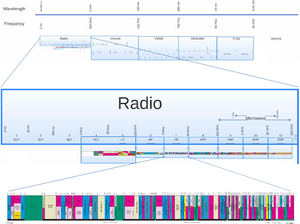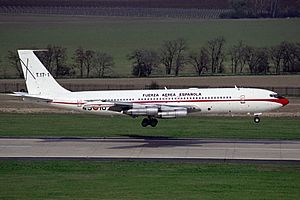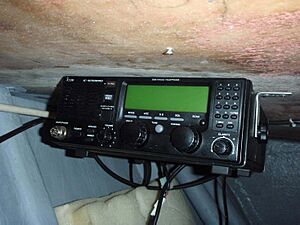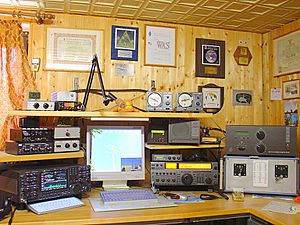High frequency facts for kids
|
Frequency range
|
3 to 30 MHz |
|---|---|
|
Wavelength range
|
100 to 10 m |

High frequency (often called HF) is a special range of radio waves. The ITU says these waves have a frequency between 3 and 30 megahertz (MHz). You might also hear it called the decameter band because its wavelengths are between one and ten decameters (which is 10 to 100 meters).
HF radio waves are a big part of what we call shortwave radio. They are amazing because they can bounce off a layer in Earth's atmosphere called the ionosphere. This bouncing helps them travel very long distances, even across continents or over mountains. This is why HF is used for things like international radio broadcasts, talking to airplanes, and by amateur radio enthusiasts who love connecting with people far away.
How HF Radio Waves Travel
The main way HF radio waves travel long distances is by "skywave" or "skip" propagation. Imagine throwing a ball and it bounces off a wall. HF radio waves do something similar! They are sent up into the sky and then bounce off the ionosphere. The ionosphere is a part of Earth's upper atmosphere that has electrically charged (ionized) atoms. When the radio waves hit this layer, they bend and reflect back down to Earth. This allows them to go far beyond what you can see, even around the curve of the Earth.
However, how well these waves travel depends on many things:
- Whether it's sunny or dark where you are sending and receiving.
- The season of the year.
- How active the sun is (like during a sunspot cycle).
- If there are auroras (northern or southern lights).
At any time, there's a best range of frequencies for communication. The Maximum usable frequency (MUF) is the highest frequency that will bounce back. The Lowest usable high frequency (LUF) is the lowest frequency that can get through without being absorbed. These change a lot. For example, in winter nights, the MUF might drop below 10 MHz. But on a sunny summer day, it can easily go above 30 MHz!
When all conditions are perfect, you can talk to people all over the world using HF. Even when conditions aren't perfect, you can often connect across continents or oceans. Sometimes, a band can be "dead," meaning no communication is possible beyond very short distances. When a path is open, you can use very low power to communicate, as long as you have good antennas and not too much interference. This is important for military, safety, and amateur radio users.
HF waves can also travel short distances along the ground. This is called a groundwave. But this distance gets shorter as the frequency gets higher. For the highest HF frequencies, groundwave travel is usually limited to about 10-20 miles.
What HF is Used For


The high frequency range is used for many important things:
- Military and Government: For secure and long-distance communication.
- Aviation: Airplanes use HF to talk to ground stations, especially on long flights over oceans.
- Amateur radio: This is very popular with hobbyists who enjoy talking to people worldwide. They like the challenge and excitement of making contacts under changing conditions.
- Shortwave Broadcasting: Many international radio stations use HF to send news and programs to listeners far away.
- Maritime Services: Ships use HF to talk to shore and other ships.
- Over-the-horizon radar: Special radar systems use HF to detect objects far away, beyond the normal radar range.
- Global Maritime Distress and Safety System (GMDSS): This system uses HF for emergency communications at sea.
- Citizen's Band Radio (CB Radio): This is a common service for local communication, usually around 27 MHz, which is in the higher part of the HF band.
- Coastal ocean dynamics applications radar: Used to monitor ocean currents and waves.
While some users have switched to satellites for communication, HF is still very important. New technologies, like Automatic link establishment (ALE), help radios automatically find the best frequency. Also, faster modems allow for more data and even video to be sent over HF. This has led to a renewed interest in HF for government networks.
Some older ways of communicating, like continuous wave Morse code and single sideband voice, are very common on HF. This is because they use less "space" on the radio spectrum. However, things like TV broadcasts, which need a lot of space, are generally not used on HF.
One challenge with HF is that it can be affected by noise. This often comes from electronic devices made by humans. For example, some BPL (Internet over power lines) systems can cause a lot of interference. Other devices, like plasma televisions, can also create noise that affects HF radio.
For airplanes flying across oceans, HF communication systems are a must-have. These systems can use frequencies as low as 2 MHz, which includes the important 2182 kHz international distress channel.
The very top part of the HF band (26.5-30 MHz) acts a bit like the lower part of the VHF band. This section is used for local communications, including CB radios, radio control for models, and paging systems.
Some radio frequency identification (RFID) tags also use HF. These are often called HFID's.
Antennas for HF
The most common antennas used for HF are wire antennas. These include simple wire dipoles or rhombic antennas. For the higher HF frequencies, you might see multi-element antennas like the Yagi, quad, and log-periodic antennas. Big shortwave broadcasting stations often use huge wire curtain arrays.
Antennas that send skywaves are usually made of horizontal dipoles or loops. These send out horizontally polarized waves. This is often preferred because the ground reflects horizontally polarized waves better, helping more of the signal go up into the sky.
For receiving signals, simple random wire antennas are often used. Also, the same directional antennas used for sending can be great for receiving. This is because they can focus on the signal coming from one direction, while ignoring noise from all other directions.
An antenna should have enough bandwidth to work well across the range of frequencies you want to use. Some antennas are "broadband" and work over a wide range, while "narrowband" antennas are more efficient at specific frequencies.
To make an HF antenna better at sending and receiving, it helps to have more metal parts exposed to the air. This improves sensitivity. However, in cities with a lot of radio noise, this also means you hear more of that noise. So, people might use a directional HF antenna or set up their antenna in a quiet, remote area and then connect it to their radio.
See also
- High-frequency Active Auroral Research Program
- High Frequency Internet Protocol
- Radio propagation
- Space weather
- Critical frequency



